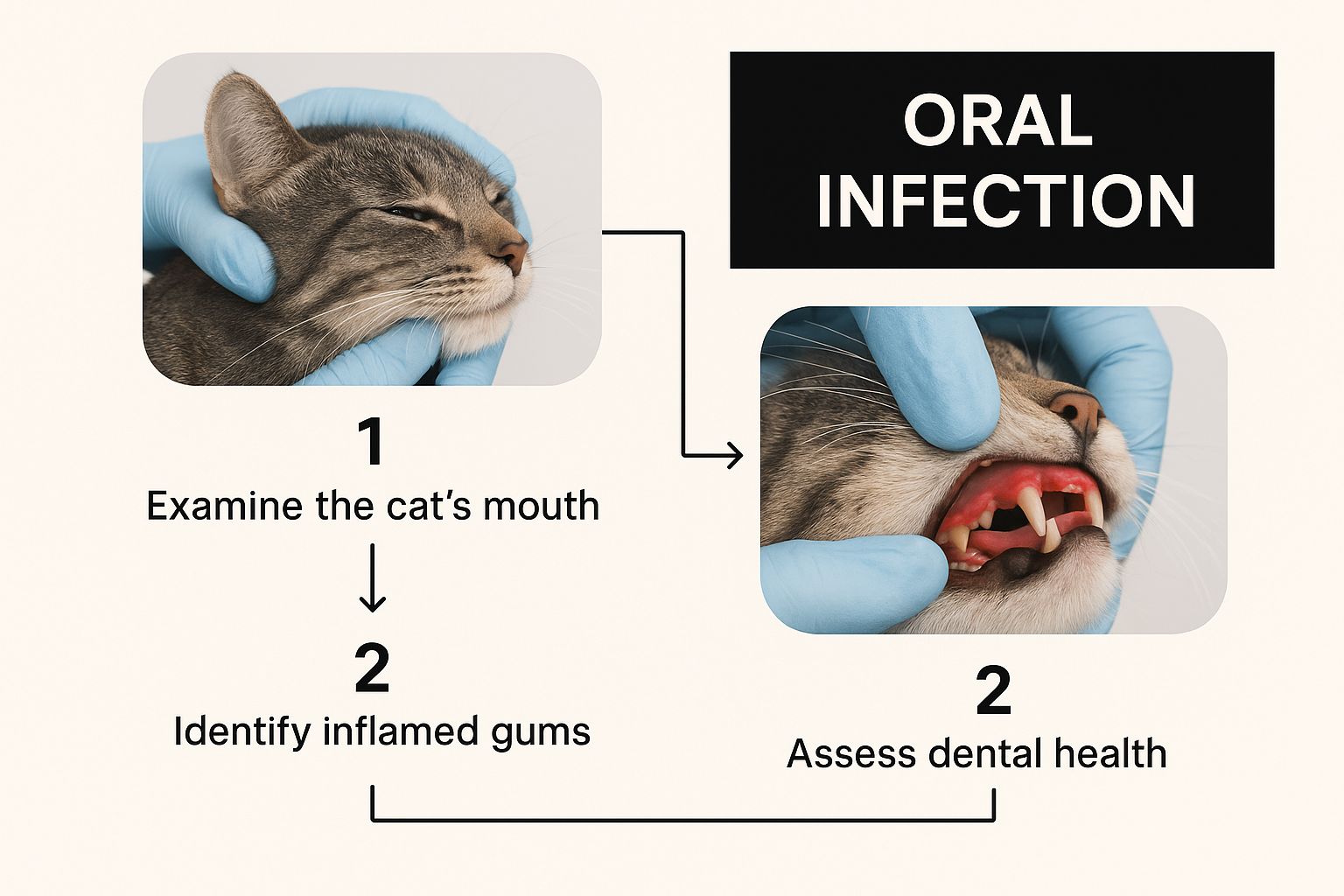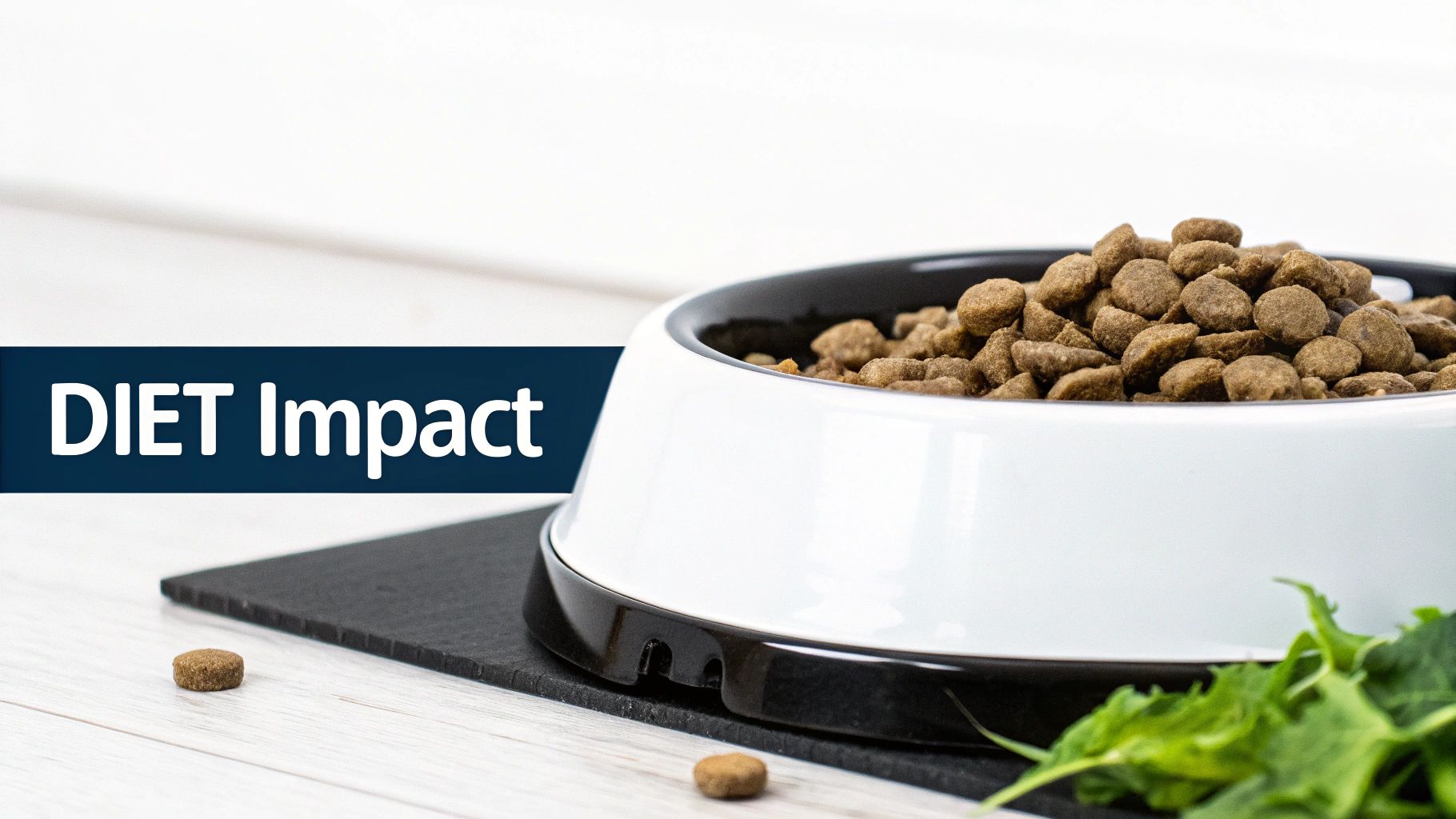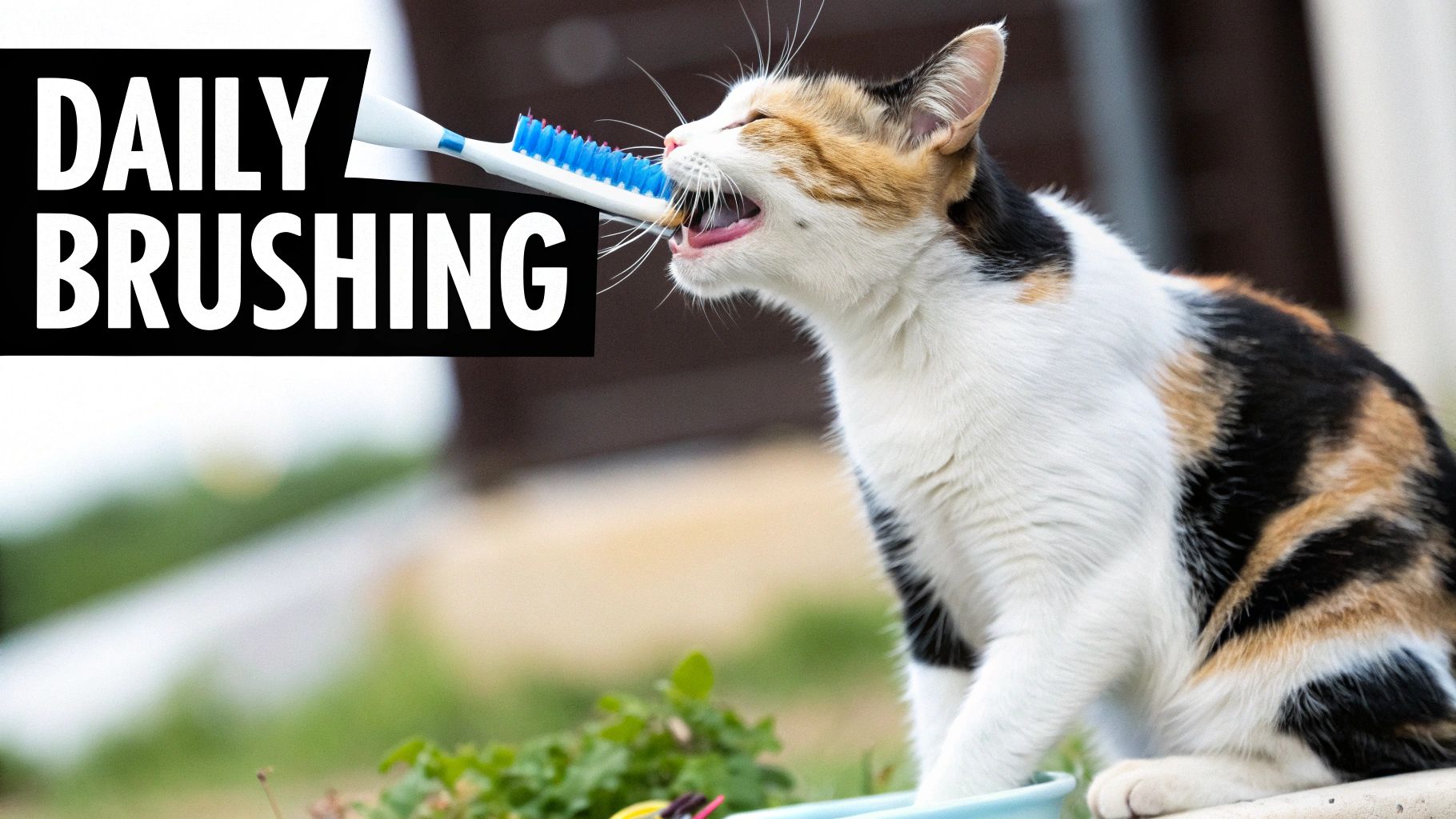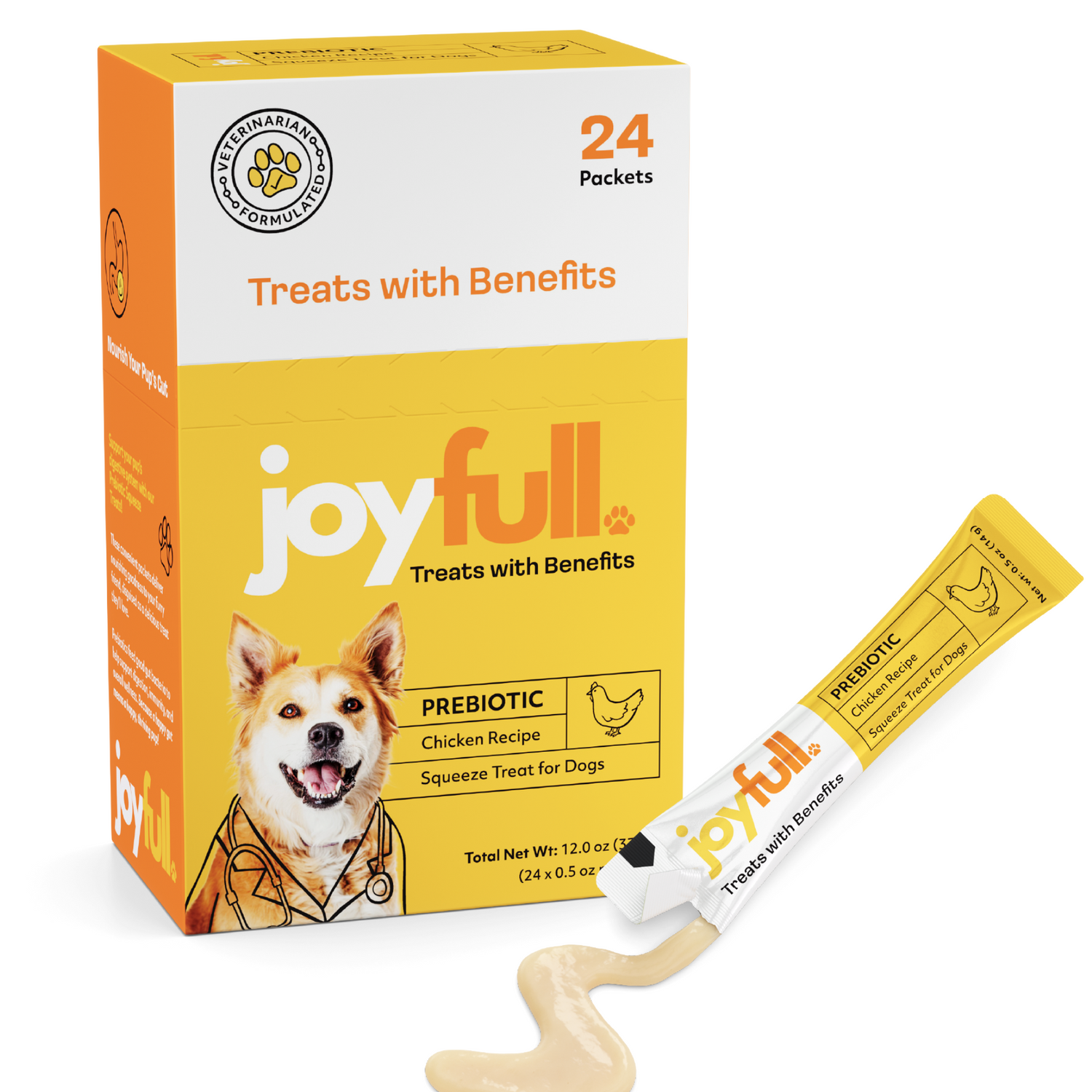
What Causes Bad Breath in Cats and When to Worry
That smell coming from your cat isn't just "cat breath." More often than not, it's a red flag waving to tell you something else is going on. While dental trouble is the usual suspect for what causes bad breath in cats, the specific scent can actually give you clues about other health issues, from a simple upset stomach to something much more serious.
Decoding Your Cat's Bad Breath
If you've ever leaned in for a snuggle only to be hit with a wave of foul odor from your cat, you're in good company. That nasty smell, known in veterinary circles as halitosis, is more than just unpleasant—it's a critical health signal that you shouldn't ignore. It's tempting to brush it off as a normal part of being a cat, but a persistent, stinky breath is your cat’s way of letting you know something is wrong.
Think of it as the "check engine" light in your car. The light itself doesn't pinpoint the exact problem, but it’s a clear sign that it's time to let an expert take a look under the hood. In the same way, your cat's breath can point to a range of issues, some minor and others that need a vet's attention right away.
Why Dental Disease Is the Top Suspect
The vast majority of the time, a cat's bad breath starts right in the mouth. The number one culprit is periodontal disease, which is a progressive inflammation of the gums and the structures that support the teeth. It's shockingly common—in fact, an estimated 70% or more of adult cats have some stage of dental disease by the time they're just three years old. You can learn more about this by checking out comprehensive guides on feline dental health from veterinary professionals.
The whole process kicks off with plaque, which is that soft, sticky film of bacteria that builds up on teeth. If it isn't brushed away, it hardens into tartar. This creates a perfect environment for nasty, foul-smelling bacteria to thrive, releasing sulfur compounds that cause that classic bad breath smell.
What Different Odors Might Mean
Interestingly, not all bad breath is created equal. The specific scent can offer some valuable clues about what's going on inside your cat. A faint fishy smell might just be the remnants of dinner, but other distinct odors can be warning signs for bigger problems.
Here's a quick guide to help you start playing detective and figure out what your cat's breath might be trying to tell you.
Decoding Your Cat's Breath: What Different Odors Mean
Use this quick guide to identify potential health issues based on the specific smell of your cat's breath.
| Odor Type | Potential Cause | What It Could Signal |
|---|---|---|
| Foul or Rotten | Periodontal Disease | This is the most common cause, pointing to plaque, tartar, gingivitis, or even painful abscesses. |
| Sweet or Fruity | Diabetes | A serious metabolic condition where the body can't regulate blood sugar levels on its own. |
| Ammonia or Urine-like | Kidney Disease | This suggests the kidneys aren't filtering waste products from the blood properly, which is a serious concern. |
| Fishy (Persistent) | Dietary or Oral Issues | It could just be from their fish-based food, but if the smell sticks around, it might signal underlying dental issues. |
Remember, this table is just a starting point. Any persistent or unusual odor is worth a conversation with your veterinarian to get to the root of the problem.
Exploring the Top Cause: Periodontal Disease
When you're trying to pin down what causes bad breath in cats, the trail almost always leads back to one primary suspect: periodontal disease. While other health issues can certainly play a role, problems inside the mouth are, by a long shot, the most common reason for that funky smell. It's incredibly widespread—in fact, a staggering 70% of cats over the age of three are already showing signs of dental disease.
To really get why this is the number one cause, it helps to understand how it all starts. Think of your cat’s mouth as a tiny ecosystem. After every meal, a sticky, invisible film of bacteria called plaque starts to form on the teeth. This is ground zero for nearly all dental trouble.
The Journey from Plaque to Pain
Plaque itself is pretty soft and can be brushed away. The real problem kicks in when that film is left to sit. Over time, minerals in your cat's saliva mix with the plaque and harden it into a crusty, yellowish-brown substance we call tartar.
You can think of tartar like barnacles on a ship—it’s rough, stubborn, and its surface is the perfect real estate for even more bacteria to latch onto. This buildup usually starts right at the gumline, that critical junction where the teeth meet the gums.
As tartar and bacteria pile up, your cat's immune system jumps into action, sending white blood cells to fight off the invasion. This constant battle at the gumline creates inflammation, which is the very first stage of periodontal disease.
Key Takeaway: That foul odor you’re smelling isn't just old food. It's the byproduct of a massive bacterial colony thriving on the plaque and tartar, releasing stinky volatile sulfur compounds directly into the air.
Stage One: Gingivitis
The first stop on the road of periodontal disease is gingivitis. This is a reversible stage where the gums get red and puffy, and they might even bleed a little when your cat chews or if you touch them. The good news is that at this point, the damage is only skin-deep, affecting the soft gum tissue while the deeper structures holding the teeth are still safe.
Think of gingivitis as the warning light on your car's dashboard. The bad breath is noticeable, and the gums are clearly irritated. If you intervene now with a professional veterinary cleaning and start a good at-home care routine, the gums can heal completely. But if it's ignored, the disease will march onward.
This visual shows just how often veterinarians are looking for oral infections—a direct result of dental disease—during routine check-ups.

It’s a clear reminder that a vet's trained eye is essential for catching these issues early, with oral health being a top concern.
Stage Two: The Point of No Return
If gingivitis is left to fester, the inflammation brews and the disease progresses into a much more serious form: periodontitis. This is where the damage becomes permanent. The bacteria start working their way under the gumline, creating deep pockets between the gums and teeth.
These pockets are the perfect hideout for the most destructive types of anaerobic bacteria—the kind that thrive without oxygen and produce the most potent, foul-smelling gases. As they multiply, they release toxins that eat away at the tissues and bone that anchor the teeth firmly in the jaw.
This advanced stage brings on more than just awful breath. You might start to see other troubling signs:
- Excessive Drooling: Sometimes with a pink or reddish tinge from blood.
- Pawing at the Mouth: A classic sign that your cat is in pain.
- Trouble Chewing: They might drop food, cry out while eating, or only chew on one side.
- Visible Tartar: A thick, brown crust on the teeth is a dead giveaway.
By now, the bad breath will likely be intense and hard to ignore. The damage to the ligaments and jawbone is irreversible and often leads to loose teeth, painful abscesses, and eventually, tooth loss. This really drives home why getting on top of dental care early isn't just about freshening your cat's breath—it's about preventing serious pain and protecting their overall health.
When It’s More Than Just Plaque
Plaque and tartar are definitely the usual suspects when your cat’s breath starts to smell a bit funky. But sometimes, that odor is a sign of something much more serious brewing just beneath the surface. Certain conditions can cause intense pain and a powerful, foul smell that’s a clear red flag. Learning to recognize these less common, but critical, problems is the key to getting your cat the help they need—fast.
One of the most severe oral conditions out there is Feline Chronic Gingivostomatitis (FCGS). This isn't just a simple case of puffy gums; it's an incredibly painful and debilitating disease.
Think of it this way: your cat’s immune system, which is supposed to be its first line of defense, goes haywire. It starts to overreact to even microscopic amounts of plaque, launching an all-out assault on the mouth's own tissues. The result is severe, widespread inflammation that makes the gums and the back of the mouth look fiery red, raw, and even ulcerated. For a cat with FCGS, every bite of food can be an agonizing experience.

Unpacking Feline Chronic Gingivostomatitis
FCGS is a major source of really bad halitosis. All that inflamed and ulcerated tissue becomes a perfect breeding ground for bacteria, which release nasty sulfur compounds. This creates an odor that is worlds away from typical "fish breath" and much more intense than standard dental disease.
And it’s more common than you might think. For instance, one study of urban feral cats found that FCGS was present in a startling 26.6% of the population. The same research revealed that in multi-cat homes, the risk for FCGS jumped by about 70% for each additional cat sharing the space. This is likely tied to the stress of crowding and repeated exposure to various infections. You can dig deeper into the complex factors behind FCGS and the study's findings.
While the exact trigger for this extreme immune reaction is still under investigation, vets believe it's a multifactorial problem, often involving an underlying viral component.
Tooth Resorption: A Painful Mystery
Another frequent cause of serious oral pain and bad breath is tooth resorption. This condition is surprisingly widespread, affecting more than half of all cats over the age of three. It happens when the body’s own cells start to break down and absorb the structure of a tooth, almost like it's dissolving from the inside out.
Imagine a cavity that starts deep within the tooth and slowly hollows it out until it creates a hole, exposing the sensitive nerves. This process is incredibly painful. It’s often why cats suddenly become sensitive around their mouths, start drooling, or have trouble eating.
The affected teeth become brittle and can easily fracture, leaving painful root fragments behind. The decay and inflammation that follow create the perfect environment for bacteria to thrive, contributing directly to what causes bad breath in cats.
What to Watch For: Unlike tartar, which is a deposit on the tooth, tooth resorption often looks like a pinkish or reddish spot right at the gumline. This is actually the gum tissue starting to grow into the defect in the tooth.
Other Oral Problems to Consider
Beyond FCGS and tooth resorption, a few other issues can create a foul odor and cause your cat significant discomfort.
- Oral Ulcers: These painful sores can pop up on the tongue, gums, or the inside of the cheeks. They can be caused by anything from underlying diseases (like kidney failure or feline viruses) to contact with caustic chemicals.
- Foreign Objects: You'd be surprised what can get stuck in a cat's mouth. A piece of a toy, a splinter from a plant, or even a blade of grass can get lodged between their teeth or in the roof of their mouth. As it sits there, it irritates the tissue and causes a localized infection, leading to swelling, pain, and a very bad smell.
- Oral Tumors: While less common, growths or tumors in the mouth can be a source of bad breath. These masses often become ulcerated and infected, producing a distinctly foul odor that shouldn't be ignored.
If you see your cat drooling, dropping food, pawing at their face, or shying away when you try to pet their head, they're sending clear signals of oral pain. When those behaviors are paired with truly terrible breath, it’s time to stop assuming it's just plaque. Schedule a visit with your vet right away.
How Your Cat's Diet and Digestion Affect Their Breath
While we know dental disease is the number one cause of bad breath in cats, what you're putting in their food bowl is a close second. The link between what a cat eats and how their breath smells is much more direct than most people think. It's not just about the temporary smell of a tuna dinner; it's about how their food affects their entire system, from their teeth right down to their gut.
It’s easy to blame fish-flavored foods for stinky breath. And sure, those can definitely leave a lingering, pungent aroma, but that kind of smell is temporary. The real dietary issue is when a cat's food is packed with poor-quality ingredients that fuel the very problems—like plaque and tartar—that lead to chronic bad breath in the first place.
Think about it: cheap foods loaded with simple carbs and fillers can throw off the natural balance of bacteria in your cat's mouth. This creates the perfect breeding ground for the nasty, plaque-forming bacteria that start the whole cycle of dental disease.
The Great Food Debate: Wet Versus Dry
The conversation around wet versus dry food for dental health is one I hear all the time, and it's full of conflicting advice. For years, the common thinking was that crunchy kibble helped scrape plaque off a cat's teeth. There's a tiny grain of truth to that, but we know a lot more now.
Most regular kibble just shatters the second your cat bites down, so it doesn't do much cleaning. It's like trying to clean your own teeth by eating a cracker—it just breaks apart. For a food to have a real, noticeable dental benefit, it has to be specifically designed for it.
You'll see that veterinary dental diets use kibble that is much larger and has a more fibrous texture. This design forces the cat to actually chew, allowing the tooth to sink into the piece before it breaks. That's what creates the scrubbing effect that can genuinely help reduce plaque.
Key Insight: A balanced, high-quality diet is far more important for your cat's overall health than getting stuck on the wet vs. dry food myth. Good nutrition bolsters their immune system, which is their best defense against the inflammation and infection caused by oral bacteria.
When the Smell Starts in the Stomach
Sometimes, the source of that awful smell isn't in the mouth at all. If you've checked your cat's teeth and gums and they look perfectly healthy, but their breath is still consistently foul, it's time to think about what's going on in their gut.
Gastrointestinal (GI) problems can absolutely manifest as bad breath. Issues like indigestion or acid reflux can cause smelly gases from the stomach to travel up and out of the mouth, resulting in a sour, unpleasant odor that seems to come from deep inside.
In the same way, a diet that just doesn't sit right with your cat can cause digestive upset that leads to stinky breath. High-quality, easily digestible proteins are key for a healthy gut. A great way to support their diet is by adding nutritious, protein-packed snacks. If you're looking for a good option, high-protein cat treats can provide a healthy boost without causing tummy troubles. At the end of the day, a happy gut often means fresher breath.
Serious Illnesses That Cause Bad Breath

While a bit of "kitty breath" from their last meal is normal, a truly foul or unusual odor can be a red flag. More than just a sign of dental trouble, persistent bad breath can sometimes be your cat's way of signaling a much deeper, more serious health problem.
Think of it as an early warning system. When a major system in your cat's body—like their kidneys or pancreas—isn't working right, waste products can build up. These byproducts eventually find their way into the bloodstream and are exhaled, creating a distinct and often alarming smell. This is why you should never ignore a sudden change in your cat's breath; it could be a clue to something happening far from their mouth.
The Ammonia Scent of Kidney Disease
One of the most telling smells is a sharp, chemical odor, almost like ammonia or urine. This is a classic indicator of chronic kidney disease (CKD), a condition that unfortunately becomes more common as cats get older. A healthy kidney's job is to act as a sophisticated filter, constantly cleaning waste products like urea from the blood.
When a cat's kidneys start to fail, they can't keep up with this crucial filtering task. Urea begins to accumulate in the bloodstream, a condition called uremia. This buildup is toxic and can lead to a range of issues, including painful mouth sores and that unmistakable ammonia-like scent on their breath.
Globally, kidney disease is a significant concern, affecting about 10-15% of aged cats. That sharp, urine-like smell is a direct result of the waste that their struggling kidneys can no longer filter out.
If you ever catch a whiff of this smell, it's time to call the vet right away. They can run blood and urine tests to assess kidney function and, if needed, create a plan to manage the disease and keep your cat comfortable. This often includes a special diet.
The Sweet Smell of Diabetes Mellitus
Another distinct scent to watch for is a strangely sweet or fruity one, sometimes described as smelling like nail polish remover. While it might not sound as nasty as ammonia, this fruity breath is a serious warning sign of diabetes mellitus, particularly a life-threatening complication known as diabetic ketoacidosis (DKA).
Here’s what’s happening: A healthy cat's body uses glucose (sugar) from its food for energy. In a diabetic cat, the body can't use glucose properly, so it desperately starts breaking down fat for fuel instead. This emergency process creates byproducts called ketones.
When ketones build up in the blood too quickly, the blood becomes dangerously acidic, leading to DKA. This is a true medical emergency. That sweet, fruity odor is the smell of excess ketones being expelled through your cat's lungs.
You’ll often notice other signs of diabetes alongside the strange breath:
- Constant Thirst: You're refilling the water bowl far more than usual.
- Frequent Urination: The litter box clumps are suddenly huge.
- Ravenous Appetite but Losing Weight: Your cat eats everything in sight but is still getting thinner.
Oral Issues vs. Systemic Disease: A Symptom Guide
It can be tough to figure out if your cat's bad breath is just a toothache or a symptom of something more. This table breaks down some common signs to help you distinguish between a localized mouth problem and a potential systemic illness.
| Symptom or Sign | Points to an Oral Cause | Points to a Systemic Cause |
|---|---|---|
| Type of Smell | "Fishy" or like rotting food | Sweet, fruity, or like ammonia/urine |
| Eating Habits | Dropping food, chewing on one side, avoiding hard food | Increased or decreased appetite, often with weight changes |
| Visible Signs in Mouth | Red or swollen gums, yellow/brown tartar, drooling | Mouth ulcers (common with kidney disease), pale gums |
| Behavioral Changes | Pawing at the mouth, less grooming, hiding | Increased thirst, frequent urination, lethargy, vomiting |
| Other Symptoms | Facial swelling, visible broken teeth | Weight loss despite a good appetite, changes in coat condition |
Remember, this guide is just a starting point. Any time you're concerned about your cat's health, the best and safest thing to do is schedule a visit with your veterinarian for a proper diagnosis.
Diagnosing and treating these illnesses requires professional expertise; for anyone wanting to dive deeper into the science, there are great resources on understanding the veterinary science behind pet health. As a cat owner, learning to recognize these specific odors is a powerful first step in spotting a potential emergency and getting your companion the help they need, fast.
Your Action Plan for Preventing Bad Breath
Knowing what causes your cat’s bad breath is half the battle. The other half? Taking action. A proactive approach doesn't just freshen their breath; it's a critical defense against the serious health problems that stem from poor dental hygiene. The best part is that a great prevention plan is all about simple, consistent habits you can start building right away.
The gold standard for at-home dental care is, without a doubt, regular toothbrushing. I know, the thought of brushing a cat's teeth can seem impossible, but with a little patience and a lot of positive reinforcement, it can become a surprisingly manageable routine. Just be sure to use toothpaste made specifically for cats—human toothpaste is toxic for them.
Introducing Toothbrushing to Your Cat
When it comes to teaching a cat to accept a toothbrush, patience is everything. If you rush it, you'll just create a bad memory, and they won't want to try again.
- Start with Touch: Get your cat used to you handling their mouth. Gently lift their lips for just a few seconds each day, and immediately follow up with a favorite treat or a bit of praise.
- Introduce the Toothpaste: Put a tiny dab of feline-friendly toothpaste on your finger and let them have a lick. Most are flavored like chicken or fish, so they often see it as a treat.
- Use Your Finger: Once they're a fan of the paste, gently rub a small amount along their gumline with your finger. Keep it brief and positive.
- Bring in the Brush: Now it’s time for the real thing. Use a super-soft cat toothbrush or a finger brush and just clean a few teeth. You can gradually work up to longer sessions over time.
Even if you only manage to brush a few times a week, you're making a huge difference in slowing down that nasty plaque buildup.
Effective Alternatives to Brushing
Let’s be real for a second: some cats will absolutely refuse to have their teeth brushed, no matter how patient you are. If your feline companion puts up a serious fight, don't worry. You still have some fantastic options to keep their mouth healthy and their breath fresh.
Don't get discouraged if brushing is a no-go. The most important thing is consistency with whatever dental care method you choose. The goal is simply to disrupt plaque from forming every day.
Plenty of vet-approved products can step in when brushing fails:
- Dental Treats and Chews: Keep an eye out for products with the Veterinary Oral Health Council (VOHC) seal. These aren't just regular treats; they have a special texture designed to scrub your cat's teeth as they chew.
- Water Additives: This is probably the easiest option—a tasteless, odorless liquid you add to their water bowl. It helps kill off plaque-causing bacteria every time they take a drink.
- Oral Gels and Sprays: You apply these directly to your cat’s gums. They work by preventing bacteria from multiplying, and you don’t need a brush to do it.
- Specially Formulated Diets: Never underestimate the power of good nutrition. A well-balanced diet strengthens their immune system, which is their first line of defense against oral inflammation. To make sure you're feeding them the right stuff, take a look at our guide on how to choose cat food for some in-depth advice.
Finally, remember that at-home care can only go so far. Professional veterinary cleanings are absolutely essential for your cat’s long-term health. For these, your cat is safely put under anesthesia, which allows the vet to do a deep, thorough cleaning above and below the gumline—something you could never do at home. This is the only way to truly remove hardened tartar and stop periodontal disease in its tracks.
Your Questions About Cat Bad Breath, Answered
When it comes to your cat's health, it's natural to have questions, especially about something as common as bad breath. Let's clear up some of the most frequent concerns so you can feel confident in caring for your cat's mouth.
Is It Normal for a Cat’s Breath to Smell a Little?
A cat's breath will never smell like roses, but it definitely shouldn't be unpleasant. A healthy cat's breath is usually pretty neutral and something you'd barely notice. If you get a whiff that's strong, foul, or makes you pull away, that’s your first clue that something isn't right.
There’s a big difference between the faint scent of their recent fish dinner and a persistent, nasty odor. The latter is a clear sign you need to investigate what causes bad breath in cats.
When Should I Start Brushing My Kitten’s Teeth?
The sooner, the better! Ideally, you should start the moment you bring them home. Getting a kitten comfortable with you looking in their mouth and gently brushing their teeth is a gift that will last a lifetime. Introducing this routine early on makes dental care feel normal, not scary.
It's a surprising fact, but dental disease can start incredibly early. Research shows many cats already have signs of it by age three. By making oral care a part of their very first vet check-ups, it just becomes another part of their happy, healthy life.
Can a Special Diet Alone Get Rid of My Cat's Bad Breath?
This is a common misconception. While a veterinary dental diet is great for slowing down new plaque and tartar, it can't magically remove tartar that has already hardened onto the teeth. If serious dental disease is causing the bad breath, the only real solution is a professional cleaning by your veterinarian.
Think of it this way: the special diet is for maintenance. After a professional cleaning gets their teeth back to a healthy state, a dental diet can be a fantastic way to keep them that way and prevent the problem from quickly coming back. It’s a preventive tool, not a cure for existing disease.
At Joyfull, we believe that a healthy life isn't just for humans—our pets deserve it, too. That's why we create formulas with clean ingredients and high-quality proteins to support your cat's overall wellness, from the inside out. Explore our better-for-you pet products at https://joyfullpet.com.

